Featured Posts
Tuesday, August 11, 2009
What is Onam
Things First In Kerala
Book : Samkshepa Vedartham
Chief Minister : E.M.S. Namboothirippad (1957-59)
College : CMS College, Kottayam
Colour Film : Kantam Becha Cot
Education Minister : Joseph Mundassery
English Medium School : Mattancheri School
Governor : B. Ramakrishna Rao
Hydro Electric Project : Pallivasal
Jewish Church : Kodungalloor
Movie : Vigatakumaran
Newspaper : Rajyasamacharam
Novelist : Appu Nedungadi
Olympian : Suresh Babu
Oscar Winner :Rasul Pookutty
Printing Press : CMS Press, Kottayam
Radio Station : Thiruvananthapuram
Sahitya Akademi President: Sardar K.M.Panicker
Speaker Legislative Assembly : R.Shankara Narayanan Thampi
Talkie Film :Balan
Travancore King : Marthanda Varma
Woman Chief Justice : Sujatha Manohar
Woman IPS officer : Srilekha IPS
Woman Minister : K.R.Gauri Amma
List of chief ministers
KERALA | |||||
1 | E. M. S. Namboodiripad | 5-Apr-1957 | 31-Jul-1959 | 1 | Communist Party of India |
2 | Pattom Thanupillai | 22-Feb-1960 | 26-Sep-1962 | 1 | Praja Socialist Party |
3 | R. Sankar | 26-Sep-1962 | 10-Sep-1964 | 1 | Indian National Congress |
4 | E. M. S. Namboodiripad | 6-Mar-1967 | 1-Nov-1969 | 2 | Communist Party of India |
5 | C. Achutha Menon | 1-Nov-1969 | 1-Aug-1970 | 1 | Communist Party of India |
6 | C. Achutha Menon | 4-Oct-1970 | 25-Mar-1977 | 2 | Communist Party of India |
7 | K. Karunakaran | 25-Mar-1977 | 25-Apr-1977 | 1 | Indian National Congress |
8 | A.K. Antony | 27-Apr-1977 | 27-Oct-1978 | 1 | Indian National Congress |
9 | P. K. Vasudevan Nair | 29-Oct-1978 | 7-Oct-1979 | 1 | Communist Party of India |
10 | C. H. Mohammed Koya | 12-Oct-1979 | 1-Dec-1979 | 1 | Indian Union Muslim |
11 | E. K. Nayanar | 25-Jan-1980 | 20-Oct-1981 | 1 | Communist Party of India |
12 | K. Karunakaran | 28-Dec-1981 | 17-Mar-1982 | 2 | Indian National Congress |
13 | K. Karunakaran | 24-May-1982 | 25-Mar-1987 | 3 | Indian National Congress |
14 | E. K. Nayanar | 26-Mar-1987 | 17-Jun-1991 | 2 | Communist Party of India |
15 | K. Karunakaran | 24-Jun-1991 | 16-Mar-1995 | 4 | Indian National Congress |
16 | A. K. Antony | 22-Mar-1995 | 9-May-1996 | 2 | Indian National Congress |
17 | E. K. Nayanar | 20-May-1996 | 13-May-2001 | 3 | Communist Party of India |
18 | A. K. Antony | 17-May-2001 | 29-Aug-2004 | 3 | Indian National Congress |
19 | Oommen Chandy | 31-Aug-2004 | 18-May-2006 | 1 | Indian National Congress |
20 | V.S. Achuthanandan | 18-May-2006 | incumbent | 1 | Communist Party of India |
HISTORY OF KERALA
Early history of Kerala is not clear. Explorations in certain regions have shown the evidences for pre-historic men of Stone Age and Neolithic era in Kerala. Early forms of monuments, burial urns, ornaments utensils and weapons found from the burials confirmed the existence of megalithic culture. Researchers are of opinion that the period of megalithic culture was from 10th century BC to 5th century AD. It is believed that the ancient Kurumba are the dolmen-builders of Kerala. It is also believed that they were the forerunners of all religions and they moved from the west coast of Kerala to all parts of the world. The Dravidians, who migrated from Mediterranean area attained their supremacy in the Kaveri and Godavari river basins and later extended to the Western Ghats. The advent of Dravidians to South India was between 1750 and 1400 B.C. Historians say that radical changes occurred in socio-cultural fields with the advent of Dravidians. The most important of them is the language. The South Indian languages including Malayalam originated from the early Dravidian language. During this period matriarchal and patriarchal systems were prevailing.

Clay sculptures of Sangam age
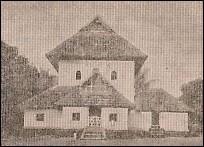
Cheraman masjid of Kodungallur
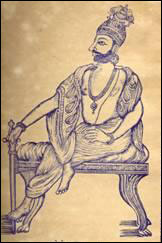
Marthanda Varma
The medieval period witnessed radical changes. During this period ‘Thara’ (village) was the lowest strata of society. The activities of a Thara were managed by Tharakootom, a general body of the village headed by the distinguished family manager or managers of the village. The matters pertaining to a Thara was discussed and finalized here. The practice was to nominate the prominent elder of the Thara as ‘Deshavazhi’ and he was the decision-implementing officer of the Thara. A number of Thara constituted a Nadu, a certain area to an extent of a district or so. Naduvazhi is the ruler of the Nadu. Nattukoottangal assisted him. The chief among the Tharas were the members of Nattukoottangal. Various Nadus constituted a country and the King was there above Naduvazhis. Once in twelve years, Mamangam was conducted to choose the King of Kerala.
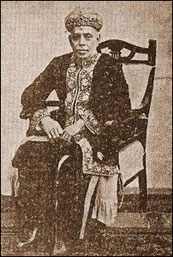
Maharaja of Kochi
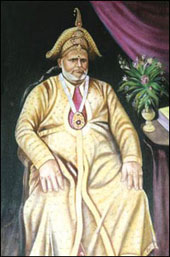
Zamorin
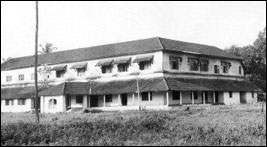
Palace of Zamorin

Vasco-da-Gama
History of modern period starts with the supremacy of British over the princely states of Travancore and Cochin. The regions of erstwhile Malabar were already occupied by the British consequent to the defeat of Tippu Sulthan.

Maharajas of Kochi and Travancore at the
time of integration
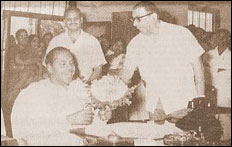
Panampilly, the last Prime Minister of
Kochi being send-off in March 1956
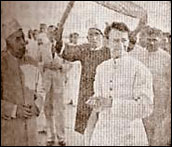
Maharajas of Kochi (left) and Travancore (right)
just before Thiru-Kochi integration
KERALA OVERVIEW

Introduction
Kerala (Keralam in Malayalam), the name is derived from a combination of two words Kera, which means coconut tree and alam, which means land. Thus the land of coconut tree is known as Keralam. Another viewpoint is that Keralam is derived from the name of the ancient dynasty of Cheras, which once ruled the state. Therefore, the land of Cheras came to be known Cheralam, which later transformed into the present day Keralam.
The history of Kerala can be traced back to the early centuries of B.C. There is mention in the famous pillar edicts of Emperor Asoka. In the second and thirteenth pillar edicts of Asoka, it was engraved that the country of “Keralaputhra” is the boundary of Asoka’s empire in the south. Mentions are there about Kerala in epics like Mahabharatha, Ramayana, Sakandapurana, Bhagavatha and Matsyapurana. Reference of Kerala is there in the Reghuvamsa written by the great poet Kalidasa. Periplus, the Greek traveler recorded in his travelogue that the King of Kerala is “Keralabothros”. The early literary works viz., Unniyadicharitham, Leelathilakom, Chandrostsavam also cited the region known as Keralam. Kulasedhara Varma, who wrote the Subhadradhananjayam Drama, was also known as “Keralachoodamani”. All these show the existence of Kerala right from the ancient period. The region was also known by different names as Malabar, Malainadu, Malayalarahyam etc. It was Al-barooni, the Arabian traveler who first called Kerala as Malabar. He took Mala from Malayalam and Bbar (kingdom) from Arab to form the word Malabar.
Kerala is one of the smallest states situated in the southernmost part of India. Before independence, three administrators ruled Kerala - two princely states of Travancore and Cochin and the Malabar provinces, under the British Empire. In 1949, the Travancore and Cochin provinces, ruled by separate Kings were merged together. After independence, the State of Kerala was constituted uniting the Travancore-Cochin States and Malabar province under the States Re-organization Act of 1956. The state came into existence on 1st November 1956.
According to the 2001 census the total population of the state is 31838619. The density of population is 819 per sq. km. The ratio between male and female is 1000:1058. Kerala has attained cent percent literacy as early in 1980s.
Geography and Physical Features
The total area of the State is 38863 sq. km. The State is bounded by the Arabian Sea on the west and by the Western Ghats on the east. The neighboring states are Tamil Nadu on the east and south and Karnataka on the north and northeast. The length of seacoast is 580 km in the west and width from east to west differs from 10 km to 120 km. It has got an unique physical feature, which divides the state into three geographical divisions viz., Malanadau (Highland with hills and mountains), Idanadu (Midland or the Plains) and Theerapradesham (Lowland or coastal region). The Malanadu has a forest cover. However, there is a reduction in the area of forest consequent on the large scale deforestation and reclamation of land for agriculture or plantation purposes. It has 44 rivers originating from the Malanadu and flowing westwards, except three that are flowing eastwards, and connected with lakes and backwaters. The longest river is the Bharathapuzha (250 km).
The climate of the state is humid tropical. The state received good rainfall as part of the two monsoon seasons during in June-August (South-West monsoon) and in October-November (North-East monsoon). Temperature differs from region to region due to the physical features of the state and it decreases when proceeds from Theerapradesham to Malanadu.
The State has a unicameral legislature. The Legislature Assembly has 141 (140 elected and 1 nominated) members. Twenty elected members are representing Kerala in the Lok Sabha and 9 members in the Rajyasabha.
Kerala is divided into 14 administrative districts. They are Kasargode, Kannur, Wayanad, Kozhikode, Malappuram, Palakkad, Thrissur, Eranakulam, Alappuzha, Kottayam, Idukki, Pathanamthitta, Kollam and Thiruvananthapuram. The districts are divided into 63 taluks and taluks are again divided into 1452 villages. Developmental activities are undertaken through 14 District Panchayats, 152 Block Panchayats and 991 Grama Panachyats. Kerala has five Municipal Corporations (Thiruvananthapuram, Kollam, Kochi, Thrissur and Kozhikode) and 53 Municipal towns.
Kerala has a unique cropping pattern. Tea, coffee, cardamom and pepper and other plantation crops are widely cultivated in the Malanadu. Coconut, pepper, rubber, paddy, tubers, cashew, mango, jack, and other tree crops are cultivated in the Idanadu. Coconut and paddy are grown on the Theerapradesham. It is also rich with mangroves and marshy places and maintains good estuarine conditions.
Kerala is the first state in India to introduce land reforms. The Land Reforms Act of 1964, which became effective from 1970 benefited more than 1,50,000 families. It altered the structure of ownership and cultivation pattern of the state. Since agriculture, as an occupation, has now become less income generative, most of such families who possessed land switched over to other occupations. On account of these, the state has developed production of cash crops instead of food crops. Thus, it has become a consumer state, which depends on neighboring states for rice, vegetables, pulses, eggs etc. However, Kerala produces more than 90 per cent of rubber and 70 per cent of coconut in the country. It is the single largest producer of crops like banana, ginger, coffee, tea and cardamom. It also contributes nearly one-third of India’s marine exports.
The traditional industries of Kerala such as Coir, Cashew and Handloom are facing serious difficulties due to various reasons. Though the state possesses basic requirements of industrial growth, it has notfully utilised its potentialities. The cash in-flow from Gulf Malayalees, contribute significantly towards the state’s economic conditions.

